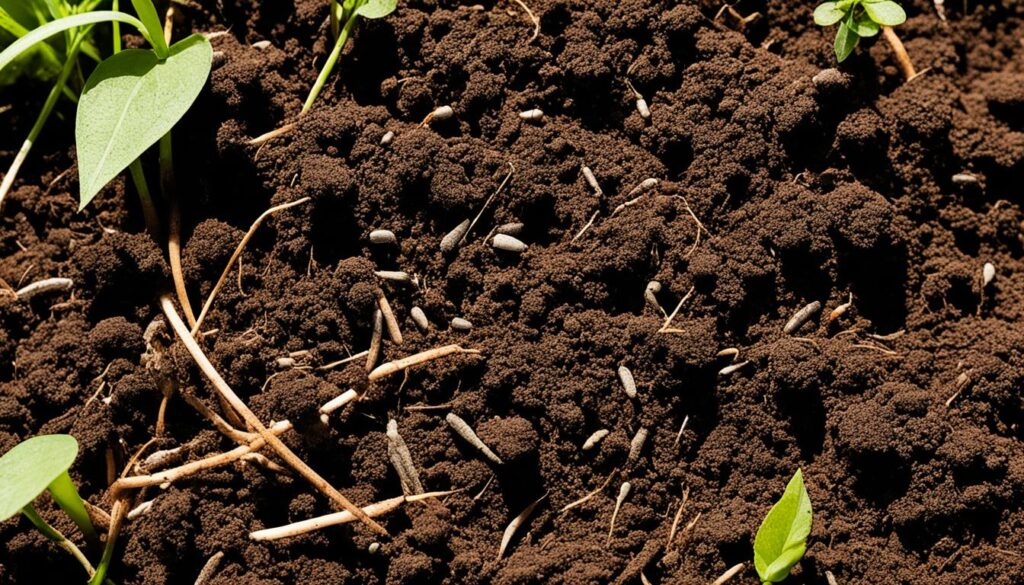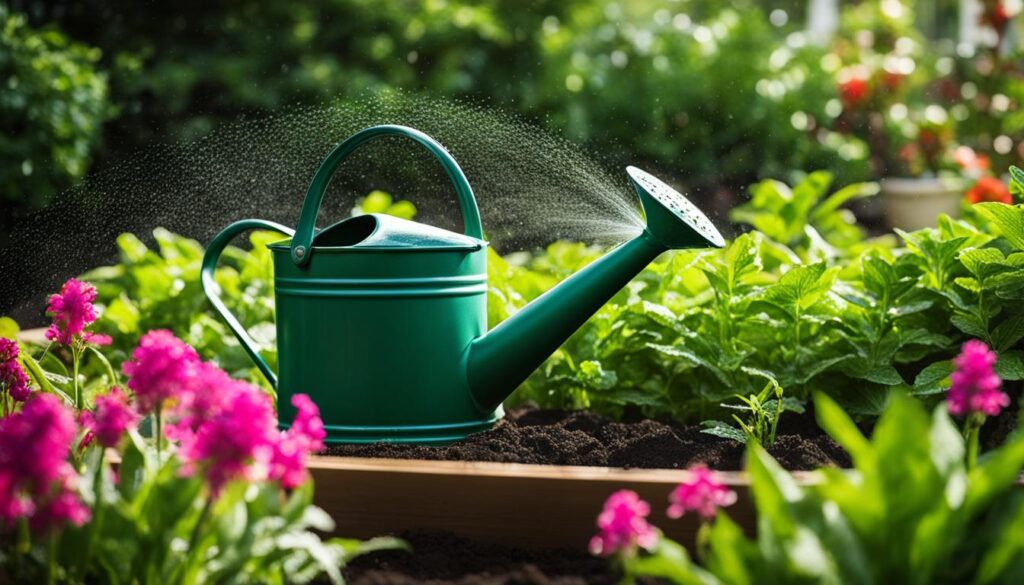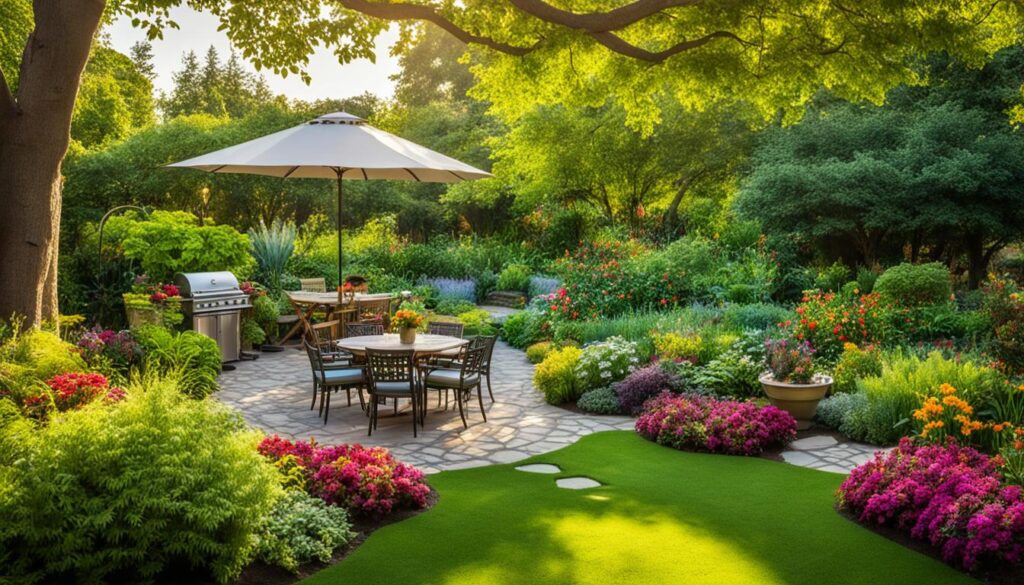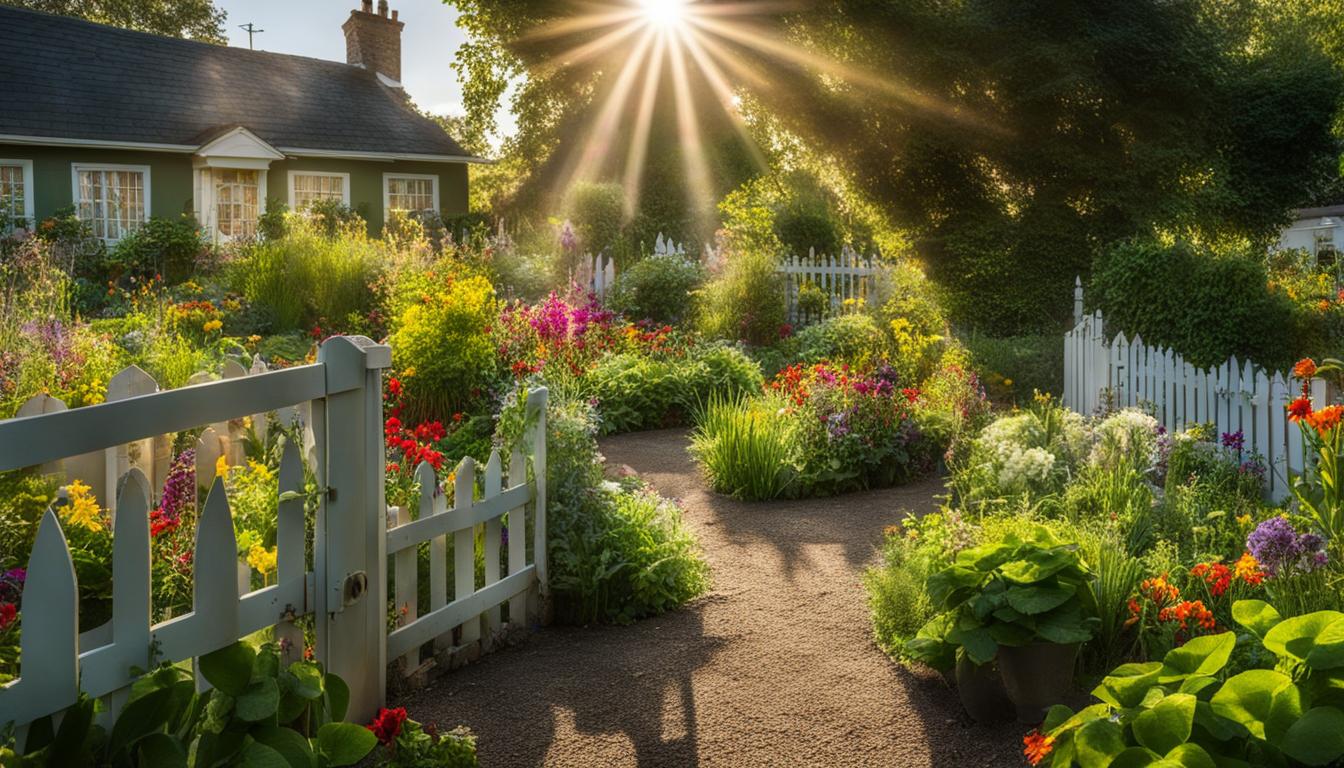Gardening is an art that brings joy, beauty, and a sense of fulfillment. If you’re looking to create a thriving garden that impresses everyone who sees it, you’ve come to the right place. I’m here to share my top tips, learned from years of experience and expert gardening advice, to help you achieve green success in your own backyard.
Creating a thriving garden requires more than just planting flowers and hoping for the best. It involves understanding the needs of your plants, implementing successful gardening techniques, and giving careful attention to every detail. By following these top tips for a healthy garden, you can transform your outdoor space into a lush paradise that will make you the envy of the neighborhood.
Key Takeaways:
- Choose plants that are well-suited to your climate for optimal growth and survival.
- Understand the composition and fertility of your soil, and make necessary amendments.
- Water your plants according to their specific needs using efficient watering techniques.
- Regularly maintain your garden by pruning, deadheading, and controlling weeds.
- Ensure your plants receive adequate sunlight by selecting the right location and creating shade structures.
Choose the Right Plants for Your Climate
In order to create a successful garden, it is crucial to choose the right plants that are well-suited to your climate. This involves considering factors such as temperature, rainfall patterns, and sunlight exposure. By selecting plants that are native or well-adapted to your region, you can ensure that they thrive in their environment.
When it comes to climate, different plants have different requirements. Some plants prefer cooler temperatures, while others thrive in warmer climates. Rainfall patterns also play a significant role in plant selection. Some plants are more drought-tolerant, while others require regular watering.
Choosing plants that are well-adapted to your climate has several benefits:
- They are more likely to survive and thrive in their natural habitat. Native plants, in particular, have evolved to withstand the specific climate conditions of your region.
- They require less maintenance and care, as they are already well-suited to the local climate.
- They are more resistant to pests and diseases, reducing the need for chemical pesticides and treatments.
“Select plants that are native or well-adapted to your region for a successful garden.”
By choosing climate-appropriate plants, you can create a garden that is not only visually appealing but also sustainable and environmentally friendly. Native plants, in particular, provide important habitat and food sources for local wildlife.
To help you make informed plant choices, here is a table highlighting some popular plant options based on different climate conditions:
| Climate Condition | Plant Recommendations |
|---|---|
| Hot and Dry | Xeriscaping plants such as succulents, agaves, and cacti |
| Tropical | Banana trees, hibiscus, and orchids |
| Mediterranean | Olive trees, lavender, and rosemary |
| Temperate | Roses, daffodils, and tulips |
Note: The plant recommendations mentioned above are just a starting point. It is always best to consult local gardening resources or visit a nearby nursery for more specific recommendations based on your exact location.
Understand Your Soil
Understanding your soil is essential for creating a healthy and thriving garden. By testing your soil and analyzing its composition, pH level, and nutrient content, you can make informed decisions on how to amend and improve it. This knowledge will help you provide the ideal environment for your plants to grow and flourish.
Soil Testing
Soil testing is a crucial step in understanding your soil’s characteristics. It involves collecting samples from different areas of your garden and sending them to a professional laboratory for analysis. The results will provide valuable insights into your soil’s composition, pH level, and nutrient deficiencies or excesses.
Soil Composition
The composition of your soil refers to the proportions of sand, silt, clay, and organic matter it contains. Each component has unique properties that affect drainage, water-holding capacity, and nutrient availability. Understanding your soil’s composition allows you to determine its texture and structure, enabling you to make appropriate adjustments for optimal plant growth.
pH Level
The pH level of your soil indicates its acidity or alkalinity. Different plants have specific pH preferences, and maintaining the correct pH range is crucial for their nutrient uptake. Testing your soil’s pH level will help you determine if it falls within the suitable range for your desired plantings or if it needs adjustment.
Nutrient Content
Soil testing also assesses the nutrient content of your soil. Nutrients such as nitrogen, phosphorus, and potassium are vital for plant growth and development. By knowing which nutrients are lacking or excessive in your soil, you can apply targeted soil amendments or fertilizers to balance and enrich the nutrient content.
Soil Amendment and Organic Matter
To improve your soil’s fertility and structure, you may need to amend it with organic matter such as compost or well-rotted manure. Organic matter enriches the soil with essential nutrients, enhances water retention, promotes beneficial microbial activity, and improves soil aeration. Incorporating organic matter into your soil will create a nutrient-rich environment that supports healthy plant growth.
To summarize, understanding your soil through testing its composition, pH level, and nutrient content is crucial for successful gardening. By amending your soil with organic matter and addressing any deficiencies or imbalances, you can create an optimal growing environment for your plants. Take the time to analyze and care for your soil, and you’ll reap the rewards of a flourishing and bountiful garden.
| Benefits of Understanding Your Soil | How to Achieve Them |
|---|---|
| Optimal nutrient availability | Amend soil with organic matter and appropriate fertilizers |
| Improved water drainage and retention | Adjust soil composition and structure |
| Optimized pH levels for specific plants | Apply lime or sulfur to adjust soil acidity or alkalinity |
| Enhanced microbial activity | Incorporate organic matter to promote beneficial microorganisms |
Quote:
“Understanding your soil is like understanding the foundation of your garden. It’s the first step towards creating a thriving and fruitful oasis.” – Gardening enthusiast

Provide Adequate Watering
When it comes to keeping your garden lush and vibrant, providing adequate watering is crucial. Understanding the watering needs of your plants and implementing efficient watering techniques can make a significant difference in their growth and overall health.
One effective technique to ensure your plants receive the right amount of water is drip irrigation. Drip irrigation delivers water directly to the plant roots, minimizing evaporation and water waste. This method allows for precise control of water distribution, preventing both under and overwatering.
Another option to consider is using soaker hoses. These hoses have tiny perforations along their length, allowing water to seep out slowly and directly into the soil. Soaker hoses provide a gentle and even water application, reducing runoff and promoting deep root growth.
Here are some watering tips to keep in mind:
- Water your plants early in the morning to minimize water loss due to evaporation.
- Water deeply and less frequently to encourage plants to develop deep roots.
- Observe your plants for signs of water stress, such as drooping leaves or soil that is too dry.
- Adjust your watering schedule based on weather conditions, as plants may require more water during hot and dry periods.
Remember, providing adequate watering is essential, but it’s equally important not to overwater your plants. Proper watering techniques can help maintain a healthy balance and ensure your garden flourishes.
“Water is the driving force of all nature.” – Leonardo da Vinci
Now, let’s take a closer look at the benefits of efficient watering techniques:
| Benefits of Efficient Watering Techniques |
|---|
| 1. Conserves water: Drip irrigation and soaker hoses reduce water waste by delivering water directly to the roots, minimizing runoff and evaporation. |
| 2. Prevents diseases: Overhead watering can contribute to fungal diseases by keeping foliage wet. Efficient watering techniques keep the leaves dry, reducing the risk of diseases. |
| 3. Saves time and effort: Drip irrigation and soaker hoses automate the watering process, saving you time and effort compared to manually watering each plant. |
| 4. Encourages deep root growth: Watering deeply and less frequently with efficient techniques promotes the development of deep and strong root systems. |
Image: Provide Adequate Watering

Practice Regular Maintenance
For a healthy and vibrant garden, regular maintenance is essential. By practicing regular maintenance tasks such as pruning, deadheading, and weed control, you can ensure that your garden stays in top shape.
Pruning is an important practice that promotes new growth and creates a well-shaped plant. By removing dead or damaged branches, you can stimulate the growth of healthy new stems and branches. Pruning also helps maintain the size and shape of plants, preventing overcrowding and improving air circulation.
Deadheading is the process of removing spent flowers from your plants. This practice not only enhances the appearance of your garden but also promotes continuous blooming. By preventing plants from producing seeds, deadheading redirects energy towards the production of new flowers, leading to a more abundant and prolonged flowering season.
Weed control is another crucial aspect of garden maintenance. Weeds compete with your plants for nutrients, water, and sunlight, leading to stunted growth and diminished health. Regularly removing weeds from your garden beds and pathways will help prevent them from spreading and ensure that your plants receive the necessary resources to thrive.
Regular maintenance also includes other tasks such as mulching, fertilizing, and monitoring for pests and diseases. These practices contribute to the overall health and vitality of your garden, keeping it looking its best throughout the seasons.
| Maintenance Task | Purpose |
|---|---|
| Pruning | Promotes new growth and maintains plant shape |
| Deadheading | Promotes continuous blooming and enhances appearance |
| Weed Control | Prevents competition for nutrients and water |
| Mulching | Conserves moisture, suppresses weeds, and improves soil fertility |
| Fertilizing | Provides necessary nutrients for plant growth |
| Pest and Disease Monitoring | Prevents and addresses infestations or infections |
Provide Adequate Sunlight
Most plants require sufficient sunlight to grow and thrive. Adequate sunlight conditions are essential for their overall health and development. It’s important to understand the sunlight requirements of different plants in order to provide them with the optimal growing conditions they need.
When selecting plants for your garden, consider their sunlight preferences. Some plants thrive in full sun, while others prefer partial shade or even full shade. By choosing plants that match the sunlight conditions in your garden, you can ensure their success.
If you have areas in your garden that receive limited sunlight or are in shade most of the day, there are still plenty of shade-loving plants that can add beauty and vibrancy to those areas. These shade-loving plants have adapted to lower light conditions and can thrive with less direct sunlight. A few examples of shade-loving plants include hostas, ferns, and impatiens.
For sensitive plants that require specific sunlight conditions, creating shade structures can help regulate the amount of sunlight they receive. Shade structures such as pergolas, shade sails, or arbors can provide filtered sunlight, protecting plants from direct and intense sunlight. These structures not only provide shade but also add architectural interest to your garden.
Importance of Sunlight for Plant Growth
Sunlight is essential for photosynthesis, the process through which plants convert sunlight into energy, enabling them to grow, produce flowers, and set fruits. Without adequate sunlight, plants may become weak, leggy, and fail to thrive. Insufficient sunlight can also lead to a decrease in the plant’s overall vigor and decrease its ability to fight off pests and diseases.
Additionally, sunlight helps regulate plant hormones, enhances flower and fruit production, and promotes vibrant foliage colors. Different plants have varying sunlight requirements, and it’s crucial to provide them with the right amount of sunlight to ensure their optimal growth and health.

The Sunlight Scale
To help you determine the sunlight conditions in your garden, consider the following scale:
| Sunlight Level | Amount of Direct Sunlight |
|---|---|
| Full Sun | 6 or more hours of direct sunlight per day |
| Partial Sun/Partial Shade | 4-6 hours of direct sunlight per day |
| Full Shade | Less than 4 hours of direct sunlight per day |
By understanding the sunlight conditions in your garden and selecting plants accordingly, you can create a thriving and visually stunning garden that brings you joy and satisfaction.
Enhance Your Outdoor Space with The Designer Rooms Outlets
Transform your garden into a stylish and functional oasis with outdoor furniture from The Designer Rooms outlets. We offer a wide range of durable and weather-resistant furniture that will enhance your outdoor space and elevate your garden experience.
Whether you have a small balcony, a spacious patio, or a lush garden, our collection of outdoor furniture has something to suit every style and need. From cozy loungers to elegant dining sets, our selection encompasses the perfect pieces to create your ideal outdoor retreat.
Our stylish furniture options are not only aesthetically pleasing but also designed for functionality. Crafted with attention to detail and quality materials, our outdoor furniture is built to withstand the elements and provide long-lasting enjoyment. With features like UV resistance, water resistance, and durability, you can trust that your furniture will maintain its beauty and functionality for years to come.

Experience the joy of alfresco dining with our dining sets, which offer a perfect blend of style and comfort. Relax and unwind on our comfortable sofas and lounge chairs, designed to provide the ultimate relaxation experience. Complete your outdoor oasis with our range of functional and decorative accessories, such as umbrellas, planters, and outdoor lighting.
Create a Cozy Outdoor Lounge Area
Design a cozy outdoor lounge area where you can unwind and entertain friends and family. Our range of outdoor sofas, coffee tables, and lounge chairs allows you to create a comfortable and inviting space for relaxation. Choose from a variety of styles, materials, and colors to match your personal taste and complement your garden design.
Host Memorable Outdoor Gatherings
Whether you’re hosting a small intimate gathering or a larger outdoor party, our dining sets are the perfect choice for creating a memorable dining experience. Crafted from high-quality materials, our dining sets combine style and functionality to provide a comfortable and elegant setting for your outdoor meals.
Add a Touch of Elegance with Outdoor Accessories
Complete your outdoor space with our wide range of outdoor accessories, designed to add the perfect finishing touch to your garden. From colorful cushions and throw pillows to stylish planters and lanterns, our accessories help create a welcoming and visually appealing outdoor environment.
| Furniture Features | Benefits |
|---|---|
| Weather-resistant | Withstands outdoor elements |
| Durable materials | Long-lasting and reliable |
| UV resistance | Maintains color vibrancy |
| Easy to clean | Hassle-free maintenance |
| Stylish designs | Enhances outdoor aesthetics |
No matter the size of your outdoor space or your personal style preferences, The Designer Rooms outlets have the perfect outdoor furniture to enhance your garden. Visit our outlets or explore our online collection to discover a wide range of stylish, functional, and durable furniture options.
Feed Your Plants
It’s essential to provide your plants with the nutrients they need to thrive and flourish. By feeding them with organic fertilizers or specialized plant food, you can ensure they receive the necessary plant nutrition for healthy growth and vibrant blooms.
“Proper nutrition is the key to a successful garden. Just as we need a balanced diet to stay healthy, plants also require a variety of nutrients to reach their full potential.”
– Sarah Green, Horticulture Expert
Organic fertilizers are an excellent option for feeding your plants as they are derived from natural sources and promote soil health. Unlike synthetic fertilizers, organic fertilizers release nutrients slowly, providing a steady and long-lasting supply. They also improve soil structure and enhance microbial activity.
On the other hand, specialized plant food is specifically formulated to meet the unique nutritional needs of different plant types. Whether you have flowering plants, vegetables, or tropical plants, there are specialized plant foods available to support their specific requirements.
When using organic fertilizers or specialized plant food, it’s important to follow the recommended application rates and frequency. Applying too much fertilizer can damage plants and contaminate the soil, while underfeeding can result in nutrient deficiencies.
Here’s a simple table showing different types of organic fertilizers and their nutrient content:
| Fertilizer Type | Nutrient Content |
|---|---|
| Compost | Organic Matter, Nitrogen (N), Phosphorus (P), Potassium (K), Micronutrients |
| Bone Meal | Phosphorus (P), Calcium (Ca) |
| Blood Meal | Nitrogen (N) |
| Fish Emulsion | Nitrogen (N), Phosphorus (P), Potassium (K) |
Remember to choose organic fertilizers or specialized plant food that align with the specific nutritional needs of your plants. Regular feeding, combined with other essential gardening practices, will result in vigorous, healthy plants that beautify your garden.
Learn from Experience and Experiment
One of the best ways to improve your gardening skills is by learning from your own experiences and experimenting with new ideas. By keeping a gardening journal, you can record your successes, failures, and valuable lessons learned along the way. This journal serves as a personal record of your journey as a gardener and helps you track your progress over time.
Experimentation is a key aspect of continuous learning in gardening. Try out new plant varieties, gardening techniques, and design ideas to see what works best for your specific garden. Don’t be afraid to step out of your comfort zone and challenge yourself with different approaches. This hands-on experience will not only expand your knowledge but also allow you to discover new possibilities and creative solutions.
“Gardening is an ongoing process of discovery and learning. Embrace the opportunity to experiment and grow.” – John Smith, Experienced Gardener
Sharing your gardening experiences and tips with fellow gardeners is another great way to learn and grow. Join gardening communities, forums, or local gardening clubs to connect with like-minded individuals who share your passion for gardening. By exchanging insights, ideas, and advice, you can gain valuable perspectives and insights from others’ experiences. It’s a wonderful opportunity to foster a sense of community and learn from one another.
Remember, gardening is a journey of continuous learning. Through personal experiences, experiments, and sharing, you can cultivate not just beautiful gardens but also a deep understanding and appreciation for the art of gardening.
| Benefits of Keeping a Gardening Journal | Tips for Effective Experimentation | Advantages of Sharing Gardening Tips |
|---|---|---|
| 1. Track the progress of your plants and garden | 1. Start small with one or two variables | 1. Gain new perspectives and insights |
| 2. Reflect on successes and learn from failures | 2. Document your process and observations | 2. Expand your gardening knowledge |
| 3. Identify patterns, trends, and correlations | 3. Take notes and record data systematically | 3. Build a supportive gardening community |
| 4. Plan future gardening activities and improvements | 4. Observe, analyze, and adjust accordingly | 4. Inspire and motivate fellow gardeners |
By learning from experience, experimenting with new ideas, and sharing your knowledge, you can continuously improve as a gardener and create a thriving garden that brings you joy and satisfaction.
Additional Resources:
- A Beginner’s Guide to Keeping a Gardening Journal
- 10 Unique Gardening Experiments to Try in Your Garden
- Joining Gardening Communities: Benefits and Tips
Understanding Vegetable Gardening Tips and Tricks
Are you a beginner gardener looking for valuable advice to ensure the success of your vegetable garden? Look no further! In this section, I will share essential vegetable gardening tips and tricks that will help you get started and maximize your harvests. From planning and preparing your garden to maintaining your plants, these practical tips will set you on the path to vegetable garden success.
1. Plan Your Vegetable Garden
Before you dive into planting, take the time to plan your vegetable garden. Consider factors such as plant spacing, sun exposure, and companion planting. This strategic approach will help optimize the use of space and ensure healthy growth for your vegetables.
2. Prepare the Soil
The key to a bountiful vegetable garden lies in the quality of the soil. Start by testing your soil to determine its pH level and nutrient composition. Amend the soil as needed, adding organic matter such as compost or well-rotted manure to improve fertility and drainage.
3. Choose the Right Vegetables
When selecting vegetables for your garden, consider your climate, available space, and personal preferences. Opt for varieties that are well-suited to your region and are suitable for your skill level as a beginner gardener. Planting the right vegetables will set the foundation for a successful harvest.
4. Provide Adequate Watering
Proper watering is crucial for the health and productivity of your vegetable garden. Keep an eye on soil moisture and provide consistent watering, ensuring that the water reaches the roots. Consider using techniques like drip irrigation or soaker hoses to deliver water directly to each plant.
5. Implement Regular Pest Control
Pests can wreak havoc on your vegetable garden, so it’s essential to implement regular pest control measures. Monitor your plants for common pests and diseases, and take proactive steps to control them. Organic pest control methods, such as companion planting and natural insect repellents, are highly recommended.
6. Practice Proper Crop Rotation
Crop rotation is crucial for maintaining soil fertility and preventing the buildup of pests and diseases. Dividing your vegetable garden into different sections and rotating crops each year will help break pest and disease cycles, resulting in healthier plants and better yields.
7. Harvest at the Right Time
The timing of your harvest plays a significant role in the flavor and quality of your vegetables. Familiarize yourself with the recommended harvesting times for each vegetable variety you have planted. Harvesting at the peak of ripeness will ensure the best taste and texture.
By following these vegetable gardening tips and tricks, you’ll be well-equipped to start your own successful vegetable garden. Remember to adapt these tips to suit your specific climate, soil conditions, and vegetable preferences. Happy gardening!
Conclusion
With the secrets to a green thumb and practical gardening tips, you can create a thriving garden that brings joy and beauty to your outdoor space. By following these tips for a successful and lush garden, you’ll be well on your way to becoming a seasoned gardener.
Remember to choose the right plants for your climate, as climate-appropriate plants are more likely to flourish. Understanding your soil and making any necessary amendments will provide the foundation for healthy plant growth. Additionally, providing adequate watering, regular maintenance, and adequate sunlight are crucial for plant health and vitality.
Don’t forget to enhance your outdoor space with stylish and functional outdoor furniture from The Designer Rooms Outlets. And, of course, feeding your plants with the right nutrients and continuously learning from your experiences and experiments will help you refine your gardening skills and achieve even greater success.
FAQ
How do I choose the right plants for my climate?
Select plants that are well-suited to your climate by considering temperature, rainfall patterns, and sunlight exposure. Choose plants native or well-adapted to your region for a successful garden.
How can I improve my soil?
Test your soil to determine its pH level, nutrient content, and texture. Amend your soil as needed with organic matter such as compost or fertilizer to improve its structure and fertility.
What is the best way to water my plants?
Learn about the watering needs of your plants and water them accordingly. Use efficient watering techniques such as drip irrigation or soaker hoses to deliver water directly to the plant roots.
How can I maintain a healthy garden?
Regular maintenance such as pruning, deadheading spent flowers, and removing weeds keeps your garden healthy and vibrant. Pruning promotes new growth, deadheading promotes continuous blooming, and removing weeds prevents competition for nutrients and water.
How much sunlight do plants need?
Most plants require sufficient sunlight to grow and thrive. Choose plants that match the sunlight conditions in your garden and create shade structures if needed for sensitive plants.
Where can I find stylish outdoor furniture for my garden?
Transform your garden with stylish and functional outdoor furniture from The Designer Rooms outlets. Choose durable and weather-resistant furniture that adds elegance to your outdoor space.
How can I provide nutrients to my plants?
Provide your plants with adequate nutrients by using organic fertilizers or specialized plant food. Follow recommended application rates and frequency to support healthy growth and vibrant blooms.
How can I learn more about gardening?
Keep a gardening journal to record your successes, failures, and lessons learned. Experiment with new plants, techniques, and design ideas. Share experiences and tips with fellow gardeners to expand your knowledge.
What are some tips for successful vegetable gardening?
Vegetable gardening tips and tricks can help beginners start their first garden successfully. These practical tips cover planning, preparing, planting, maintaining, and maximizing harvests.
How can I create a thriving garden?
With the secrets to a green thumb and practical gardening tips, you can create a thriving garden that brings joy and beauty to your outdoor space. Follow these tips for a successful and lush garden.

